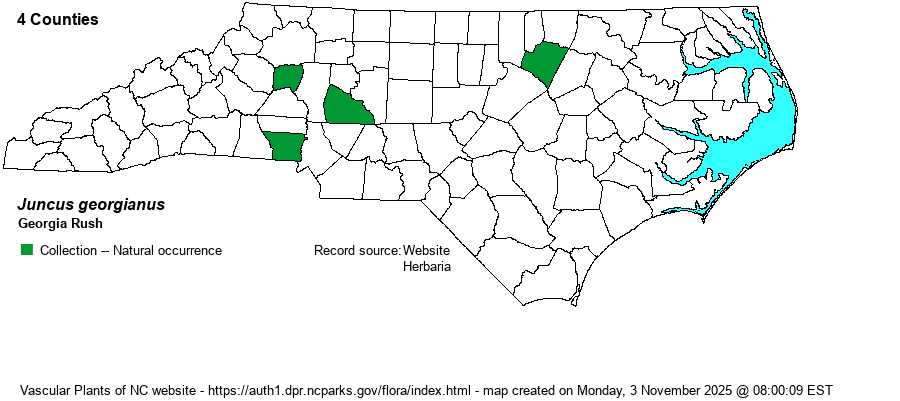| Author | Coville | |
| Distribution | Scattered sites in the Piedmont. Known thus far from Alexander, Franklin, Gaston, and Rowan counties. A specimen from Whiteside Mountain in Macon County (at MIN) has involucral leaves much longer than the inflorescences and appears to be Path Rush (J. tenuis). Surprisingly not yet collected in Wake County, which has much seemingly suitable habitat.
Restricted to the Piedmont of NC, SC, GA, and AL. | |
| Abundance | Rare and sporadic, with large gaps between occurrences -- owing to its very restricted flatrock habitat (tiny patches on the landscape). The last specimen was collected, apparently, in 1990. As a result, the NCNHP now considers the State Rank as SH (Historical), changed from S1? It is a Significantly Rare species. The website editors feel that the species is perhaps under-collected and should still be present, though with the last collection over 30 years ago, the SH designation is appropriate. | |
| Habitat | Granitic flatrocks and granitic domes, but only where there are shallow depressions (as this is a "wetland" species). |
| Phenology | Flowering and fruiting June-August. | |
| Identification | Georgia Rush is very similar to the ubiquitous Path Rush (J. tenuis), but the lowest involucral leaf is shorter than the inflorescence and the leaf sheath auricle is very short (vs. prolonged). It is closely related to Lopsided Rush (J. secundus), but differs in longer tepals (3.6-5.1 mm vs. 2.5-3.5 mm) and broader capsules (ellipsoid to globose vs. ellipsoid to narrowly ellipsoid). Both species may have heads arranged along one side of a branch (secund), apparently always so in Lopsided Rush. Note that this species is restricted to shallow depressions on flat granitic rock surfaces, though Path Rush and Lopsided Rush could occur at flatrocks. | |
| Taxonomic Comments | None
NOTE on Juncus: These "grasslike" or "sedgelike" plants occur in most habitats, especially where moist or wet. They can immediately be told from grasses and sedges by the presence of 6 tepals (petal-like) that surround the fruit. These tepals can be thought of as analogous to sepals and petals of, say, lilies or trilliums. Most species have brown, chestnut, or reddish tepals and dark brown fruits. The flowers occur in few- to many-flowered heads. Leaves are nearly all basal and round in cross-section. Stems are unbranched, except for the inflorescence. Fruits are termed capsules and contain many tiny seeds. | |
| Other Common Name(s) | Flatrock Rush | |
| State Rank | SH | |
| Global Rank | G3 | |
| State Status | SR-O | |
| US Status | | |
| USACE-agcp | | |
| USACE-emp | | |

